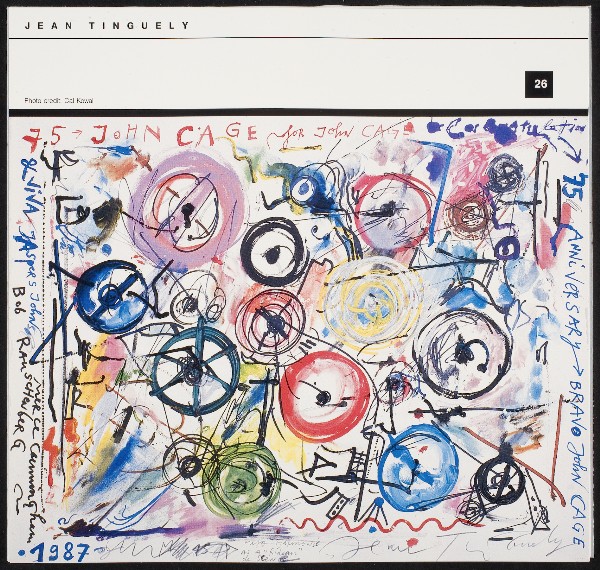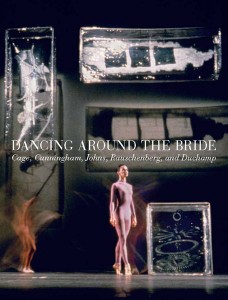Visual Arts/Book Review: Still Cagey at 100
I can’t understand why people are frightened of new ideas. I’m frightened of the old ones. — John Cage to Richard Kostelanetz, 1988
Prepared Box for John Cage. At the Davis Museum at Wellesley College, through June 9, 2013.
Dancing Around the Bride: Cage, Cunningham, Johns, Rauschenberg, and Duchamp. Edited by Carlos Basualdo and Erica F. Battle. The Philadelphia Museum of Art in association with Yale University Press, 432 pages, $55.
By Debra Cash.
Throw the IChing, twiddle the radio dials, rain down the confetti! John Cage is having a blow out of a centennial, and everyone from the academic pooh-bahs to the 3 a.m. deejays are invited. For the past year or so, there has been some event somewhere marking the 100th birthday of the beloved composer, theorist, and mushroom hunter. Boston-based Cage specialist Stephen Drury has been hopscotching the world with his impeccable version of Cage’s works, including a recent Gardner Museum performance with the Callithumpian Consort. A Miami conference this coming week features Michael Tilson Thomas, new-music vocalists Joan La Barbara and Meredith Monk, soprano Jessye Norman (!), and students dancing work by Cage’s lifelong creative and personal partner, choreographer Merce Cunningham.
Cage is not restricted to the cognoscenti anymore. I almost fell off my chair a couple of weeks ago reading someone named Kevin on Glassdoor who recommended that if a hiring manager asked, “What’s your favorite song? Perform it for us now” the best answer would be “4’33.” “And just sit there silent for the next four and half minutes.” (If you’re not in on the joke, catch up by reading Kyle Gann’s erudite No Such Thing As Silence).
At Wellesley’s Davis Museum, curator Elaine Mehalakes has literally unpacked the tribute of an earlier era, Prepared Box for John Cage, created in 1987 for a Chicago exhibition in honor of Cage’s 75th birthday. Allan Kaprow, the artist best remembered for his role in creating the “happenings” of the 1960s, solicited contributions from Cage’s circle, which were reproduced or photographed, compiled and paginated, and slipped into a cardboard box decorated with a street map of downtown Chicago. The box—and the Davis displays it—was held together with yellow, blue, and (now fading) red rubber bands that could either be removed to get at the goodies inside, rearranged to augment or challenge the existing street grid, or for all I know, plucked like the prongs of a thumb piano. Removed from the box and hung at eye level in their original sequence, the contents of the prepared box are dull to look at: a sea of white paper rectangles aligned along an eye-level spine, pages “typed” in black, red, blue, and green with tiny interruptions of color drawings.

Jean Tinguely, Untitled from PREPARED BOX FOR JOHN CAGE, 1987, Gift of Carl Solway Gallery, Cincinnati, OH
Prepared Box is less a show about seeing than about reading. It is not “about” Cage, per se—his own art is mostly “offstage,” setting a context and a standard. It is, however, about the vitality and art historical significance of the people who admired and loved him. Prepared Box is also about how an aesthetic of freedom became both a set of self-conscious prescriptions—artists piously signing on to canonical Cagean methods—and an “all free” permission slip for frolicsome Fluxus experimenters.
In 1987, a few of the invitees dashed off RSVPs apologizing that they were too busy to take up Kaprow’s invitation, and the methodologically pure Kaprow turned those refusals into publishable pages. (Talk about not taking no for an answer!) Nam June Paik’s page is scratched with proofreaders’ insertions as he free-associates to the English word “toast.” Allen Ginsberg takes a series of photographs out his kitchen window and reminisces about the process of noticing what he notices. Barbara Moore writes a tribute that would be acceptable for say, a Kennedy Center honor, writing “one man dredged from our ears the waxy accumulations of centuries. So many squeaky clean ears is something to ponder,” but her politeness is juxtaposed with a macabre black and white photo: Joseph Beuys’s assemblage of a severed ear resting on a rectangle of grey felt.
Some of the artists clearly created new works in response to Kaprow’s laudation, like the very funny Claes Oldenburg drawing which, in a nod to the innards of Cage’s prepared pianos, shows a colossal mushroom and screw strapped down under taut wire. The mushroom and screw twist like inanimate Gullivers, casting their shadows on the pin-headed figures below. Other participants repurposed existing projects, like the photograph of “Trophy IV,” the 1961 combine showing a crumpled, aluminum-looking shin and foot with a dark, leather shoe suspended from a lintel that Robert Rauschenberg said was inspired by the day the stage floor broke under one of Merce Cunningham’s “great leaps.”

Robert Rauschenberg, Untitled from PREPARED BOX FOR JOHN CAGE, 1987, Gift of Carl Solway Gallery, Cincinnati, OH
The most successful works, however, are the wordy ones where Cage’s instructions move beyond in-jokes to flow toward fresh experiences. I’m thinking of the musical score Peter Frank provides that includes a finale where “all musicians brandish their instruments menacingly/-at each other/-at the audience.” If you go to Wellesley, take advantage of the iPod nanos the Davis supplies to sample Cage’s music while puzzling out his idiosyncratic music notation strategies. The aural selections include Cage’s surprisingly reticent Music for Marcel Duchamp (1947), which was recorded in 1969 by pianist Jeanne Kerstein. Its steady treble persistence sounds like rain dripping off a tree. There’s also a performance of the 1957–58 Concert for Piano and Orchestra, where you can clearly hear boos mixed in with the cheers, and John’s patient speech, syllables ringing in a quizzical tenor as if he were giving a phonetic reading in a foreign language, as he recites segments of his now-famous Indeterminacy.
One of the Cage centennial year’s Big Events, an exhibition at the Philadelphia Museum of Art, closed in January but has been commemorated in the handsome, tripartite, hardcover catalog Dancing Around the Bride: Cage, Cunningham, Johns, Rauschenberg, and Duchamp, edited by Carlos Basualdo and Erica F. Battle and designed by Takaaki Matsumoto. The Bride in question, of course, is Duchamp’s 1912 The Bride Stripped Bare by Her Bachelors, Even (La mariée mise à nu par ses célibataires, même), most often called The Large Glass (Le Grand Verre). Philadelphia has the most extensive collection of Duchamp work in the world.
The volume draws on both the acknowledged and implicit affinities among these men, highlighting the radical interdisciplinarity that led the artists to discover “new forms of beauty” and “a common attitude toward time” in the intimate village that was avant-garde New York in the years after the Second World War. The principals are represented by their own writings (Jasper Johns now the lone survivor), alongside the assessments of heavyweight contemporaries Susan Sontag, Calvin Tomkins, and Rosalind Krauss. Art historian Paul B. Franklin, who works with the Duchamp family to help manage the artist’s estate, provides the valuable chronology.
As Tomkins tells it, Cage had met Duchamp in 1942 but, abashed, “stayed away out of admiration” until in the early 1960s when he asked Duchamp to give him chess lessons. “The ability to contradict himself, after all, was one of the freedoms built into Duchamp’s invaluable questions about art, life, and the ever-changing relationships between them,” Tomkins says, adding that Cage said,”I literally believe Duchamp made it possible for us to live as we do.”

Reunion, 1968, Performance Marcel Duchamp and John Cage, chess game on sounding board, Photo: Shigeko Kubota.
What the Davis show misses in visual interest, Dancing Around the Bride partially amends: its 62 pages of color plates, including some that show work that was not in the exhibition but is referred to in the catalog text, gives two-dimensional works their due, although it would have been nice to have an image of the 9′ tall Bride hung in the gallery alongside a museum patron where, in the words of Jasper Johns, its two-sided glass “involves you with yourself and the room you’re in, and it seems to require a kind of alertness on your part.”
My recommendation, though, comes from the 1987 Fluxus instructions of Japanese artist Mieko Shiomi: “Take this card with you and make a performance which will transform the card into a mirror reflecting sunbeams toward John Cage.” If you do so, it will be the unpredictable, practical, and numinous celebration John Cage deserves.
c2013 Debra Cash

